Saludos estimados amigos de la plataforma Hive, sean todos bienvenidos una vez más a mi blog; este espacio está destinado a la difusión de material referido al fascinante mundo de los artrópodos. En el presente artículo se darán a conocer datos de interés sobre un lepidóptero de la familia Nymphalidae, específicamente sobre el género Anartia.
Greetings dear friends of the Hive platform, you are all welcome once again to my blog; this space is intended for the dissemination of material related to the fascinating world of arthropods. In the present article, interesting data about a lepidopteran of the family Nymphalidae, specifically about the genus Anartia, will be disclosed.
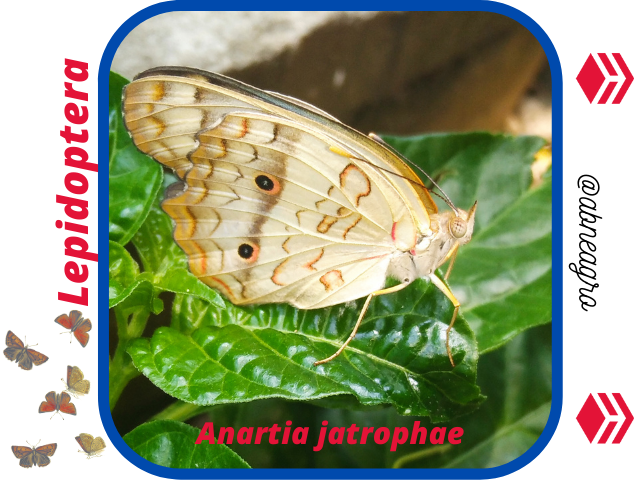
La familia Nymphalidae perteneciente al orden Lepidoptera, es uno de los grupos de mariposas más conocidos en el mundo. Estos insectos son de hábitos completamente diurnos, por este motivo gran parte de sus especies son habituales de ver sobrevolando las plantas o cerca de reservas naturales de agua. De igual manera, son muchos los aspectos que llaman la atención de este tipo de artrópodo volador, principalmente se aprecia mucho los colores llamativos que poseen, los cuales no son más que herramientas evolutivas para poder reducir el riesgo de ser consumidas por ciertos animales, el tipo de tonalidades que poseen es lo que se conoce dentro del campo investigativo como coloración aposemática.
Por otro lado, todas las mariposas de esta familia son muy fáciles de diferenciar de otras familias de lepidópteros, esto es debido a que este grupo monofilético posee características muy propias y que son fácilmente apreciables a simple vista; sin embargo, el mayor problema puede venir a la hora de determinar algunas especies en concreto, ya cuando nos adentramos en subfamilias o en tribus, pueden generarse ciertas confusiones, sobre todo por los diferentes puntos de vista que puedan tener algunos expertos. Esta familia alberga un aproximado de 600 géneros y más de 5.500 especies distintas, pero hablar de números exactos sobre la cantidad de géneros y cuantas especies pertenecen a cada uno de estos puede ser un poco problemático, ya que estos grupos están en constante estudio, por lo que algunas especies pueden ser movilizadas de un género a otro a medida que se hacen nuevos descubrimientos.
The family Nymphalidae belonging to the order Lepidoptera, is one of the best known groups of butterflies in the world. These insects are completely diurnal, which is why most of their species are commonly seen flying over plants or near natural water reservoirs. Similarly, there are many aspects that draw attention to this type of flying arthropod, mainly much appreciated the striking colors they have, which are nothing more than evolutionary tools to reduce the risk of being consumed by certain animals, the type of shades they have is what is known within the research field as aposematic coloration.
On the other hand, all the butterflies of this family are very easy to differentiate from other families of Lepidoptera, this is because this monophyletic group has very own characteristics and are easily visible to the naked eye; however, the biggest problem may come when determining some species in particular, and when we go into subfamilies or tribes, some confusion can be generated, especially by the different points of view that may have some experts. This family is home to approximately 600 genera and more than 5,500 different species, but talking about exact numbers about the number of genera and how many species belong to each of these can be a bit problematic, since these groups are constantly being studied, so some species can be moved from one genus to another as new discoveries are made.
.png)
La especie Anartia jatrophae es uno de los ejemplares de lepidóptero más comunes en el continente americano, realmente son muy fáciles de ver durante el día, sus poblaciones se reproducen satisfactoriamente en espacios urbanos ya que generalmente no son un problema en agroecosistemas sus orugas, de manera que, pueden vivir en armonía con nuestra especie. El género Anartia es muy pequeño, ya que tan solo posee hasta el momento un total de 5 especies, siendo estos la: Anartia chrysopelea, Anartia lytrea, Anartia amathea, Anartia fatima y la Anartia jatrophae; este último puede poseer ligeras diferencias en el tema de coloración según el país en el que sea apreciada, por lo que en muchos escritos se pueden encontrar como Anartia jatrophae intermedia, Anartia jatrophae guantanamo, Anartia jatrophae semifusca, entre otras.
The species Anartia jatrophae is one of the most common lepidopteran specimens in the American continent, they are really very easy to see during the day, their populations reproduce satisfactorily in urban spaces since their caterpillars are generally not a problem in agroecosystems, so that they can live in harmony with our species. The genus Anartia is very small, since it only possesses so far a total of 5 species, being these the: Anartia chrysopelea, Anartia lytrea, Anartia amathea, Anartia fatima and the Anartia jatrophae; the latter may possess slight differences in the subject of coloration according to the country in which it is appreciated, so that in many writings it can be found as Anartia jatrophae intermedia, Anartia jatrophae guantanamo, Anartia jatrophae semifusca, among others.
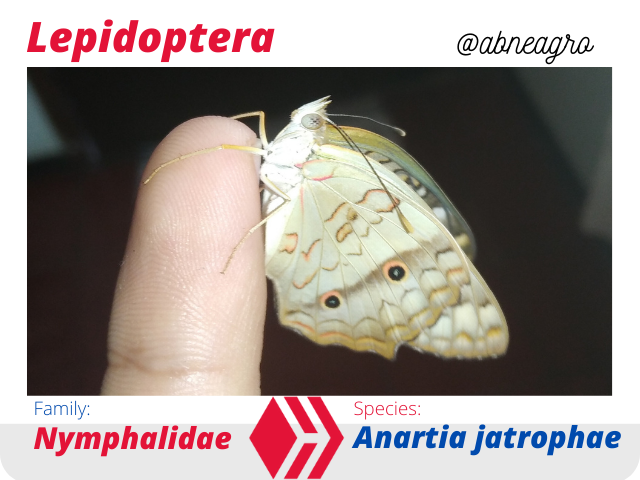.png)
Las integrantes de la familia Nymphalidae destacan no solo por poseer interesantes colores, sino que también llama mucho la atención uno de sus pares de patas, el cual es un poco atrofiado y al estar posadas parecieran que solo tienen 2 pares de patas, este par modificado es más pequeño que el resto de extremidades y en muchos casos no es funcional. Sobre este último punto desconozco realmente la utilidad de dichas patas cortas, nunca he recibido respuestas válidas que me ayuden a solventar mi duda, sin embargo, misterios o interrogantes como estas aún hay muchas en la naturaleza, por lo que el trabajo realizado por los investigadores continua en constante avance para solventar muchas de las cosas que nos generan dudas en los espacios naturales y con cada uno de los componentes bióticos que hacen vida activa en dichos espacios.
The members of the family Nymphalidae stand out not only for their interesting colors, but also for one of their pairs of legs, which is somewhat atrophied and when perched they seem to have only 2 pairs of legs, this modified pair is smaller than the rest of the limbs and in many cases it is not functional. On this last point I do not really know the utility of these short legs, I have never received valid answers that help me to solve my doubt, however, mysteries or questions like these there are still many in nature, so the work done by researchers continues in constant progress to solve many of the things that generate doubts in natural spaces and with each of the biotic components that make active life in these spaces.
.png)
Este lepidóptero es comúnmente conocida como "pavo real blanco", apodo claramente dado por tener colores muy claros en diversas partes de sus cuerpos, principalmente en la parte baja de sus alas, en donde tienen una tonalidad mucho más blanca. De igual manera, por los bordes de sus alas puede presentar un color anaranjado, este color puede ser muy fuerte o más opaco, ayudando esto a diferenciar tanto a machos como a hembras, ya que estas últimas son generalmente más grandes y poseen una coloración más apagada.
Otro de los aspectos que ayudan a diferenciar a la Anartia jatrophae de las demás integrantes del género Anartia, es la disposición de 3 manchas negras con bordes naranja que presentan en cada uno de su par de alas, teniendo uno de estos puntos en sus alas anteriores, mientras que en las posteriores poseen los otros 2 puntos, teniendo un total de 6. En las fotografías solo se pueden apreciar 4, pero en realidad la mancha media está oculta por las alas anteriores y solo pueden apreciarse las 6 cuando las alas están desplegadas por completo.
This lepidopteran is commonly known as "white peacock", nickname clearly given for having very light colors in various parts of their bodies, mainly in the lower part of their wings, where they have a much whiter shade. Similarly, by the edges of its wings may have an orange color, this color can be very strong or more opaque, helping this to differentiate both males and females, as the latter are generally larger and have a duller coloration.
Another aspect that helps to differentiate the Anartia jatrophae from the other members of the genus Anartia, is the arrangement of 3 black spots with orange edges that they present in each of their pair of wings, having one of these spots on their anterior wings, while in the posterior ones they have the other 2 spots, having a total of 6. In the photographs only 4 can be seen, but in reality the middle spot is hidden by the forewings and the 6 can only be seen when the wings are fully unfolded.
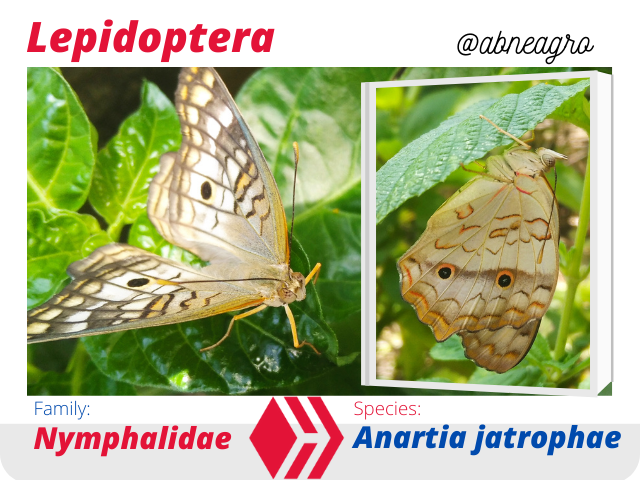.png)
Por otro lado, las alas forman parte esencial en la vida de estos insectos, son voladores por naturaleza, por lo que necesitan de sus alas para buscar alimento, huir de depredadores, mimetizarse con su entorno, regular temperatura y para buscar pareja, así que, perder alguna de estas partes de sus cuerpos es una condena total para ellas.
Las manchas en sus alas son empleadas para llamar mucho más la atención, de manera que, muchos pueden pensar que mientras más se hagan notar pueden ser víctimas más fáciles de algún depredador, pero en realidad el efecto que esto genera es lo contrario, ya que aquello que llama mucho la atención en la naturaleza es porque su ingesta puede generar problemas, de esta manera evitan se presas de muchos animales, pero también estos colores o manchas pueden ser tan solo una trampa o un engaño, es decir, que a pesar de que alguna mariposa posea vivos colores no quiere decir que posea alguna toxina en su cuerpo, sino que usa estos colores para hacer creer al resto que no es consumible, aumentando significativamente sus posibilidades de vivir en un entorno tan hostil como lo es la naturaleza.
On the other hand, wings are an essential part of the life of these insects, they are flying by nature, so wings are necessary tools to find food, flee from predators, mimic their environment, regulate temperature and to find a mate, so, losing any of these parts of their bodies is a total condemnation for them.
The spots on their wings are used to draw much more attention, so that, many may think that the more they are noticed they can be easier victims of a predator, but in fact the effect that this generates is the opposite, since that which attracts much attention in nature is because its ingestion can generate problems, thus avoiding being prey to many animals, But also these colors or spots can be just a trap or a deception, that is to say, that although a butterfly has bright colors does not mean that it has any toxin in its body, but uses these colors to make others believe that it is not consumable, significantly increasing their chances of living in an environment as hostile as nature.
.png)
Las plantas hospederas de las orugas de esta mariposa son generalmente silvestres, por lo que muy rara vez son un problema dentro de la agricultura, además de que las hembras suelen colocar pocos huevos y los colocan de manera individual sobre las plantas, es decir, no colocan muchos huevos en un mismo sitio, de esta manera evita la competencia entre sus futuras generaciones por alimento.
Los machos si suelen ser muy territoriales, ellos se mantienen en la constante alerta de proteger una pequeña zona de otros lepidópteros intrusos y de otros machos que se acerquen al área que la mariposa esté custodiando.
The host plants of the caterpillars of this butterfly are generally wild, so they are very rarely a problem in agriculture, in addition to the fact that the females usually lay few eggs and place them individually on the plants, that is, they do not place many eggs in the same place, thus avoiding competition among future generations for food.
Males tend to be very territorial, they are constantly on the alert to protect a small area from other intruding lepidoptera and other males that approach the area that the butterfly is guarding.
.png)
Durante los primeros instares de vida, este insecto presentará un cuerpo eruciforme con un predominante color negro, a lo largo de este cuerpo la oruga posee ramificaciones con espinas y pubescencia sensorial, este es su mecanismo de defensa, como ya sabrán son muchas las orugas de lepidópteros que presentan pubescencia urticante, siendo algunas consideradas de importancia médica por los posibles estragos que estas toxinas pueden generar sobre el organismo humano, afortunadamente, la Anartia jatrophae no representa peligro para el humano durante sus primeras etapas de vida (oruga); sin embargo, siempre hago el llamado de atención a no manipular a las orugas que presenten espinas o pubescencia, de esta manera se evitan posibles accidentes y malos ratos. Asimismo, a medida que la oruga se alimente, su cuerpo irá aumentando de tamaño, la coloración se hace más notoria y aparecen manchas anaranjadas en las ramificaciones con espinas que poseen en sus cuerpos.
During the first instars of life, this insect will present an eruciform body with a predominant black color, along this body the caterpillar has branches with spines and sensory pubescence, this is its defense mechanism, as you know there are many lepidopteran caterpillars that present urticating pubescence, fortunately, the Anartia jatrophae does not represent any danger to humans during its first stages of life (caterpillar); However, I always call attention not to handle caterpillars that present spines or pubescence, thus avoiding possible accidents and unpleasant surprises. Also, as the caterpillar feeds, its body will increase in size, the coloration becomes more noticeable and orange spots appear on the branches with spines on their bodies.
.png)
Estos insectos son holometabolos, lo que quiere decir que presentan una metamorfosis completa, de manera que, este artrópodo comenzará siendo un huevo amarillento, posteriormente saldrá una pequeña oruga que irá aumentando progresivamente su tamaño, mudando a medida que crece la cubierta cuticular que protege su cabeza, siendo esta la única parte rígida de todo su cuerpo durante estas fases iniciales. Luego viene la fase de crisálida o pupa, durante esta etapa las orugas no se alimentan y comienzan a sufrir rupturas orgánicas que dan origen a nuevos órganos y otras partes necesarias para esa nueva etapa que está por emerger; la crisálida es verde y presenta puntos negros en toda su extensión, una vez que el adulto sale, esta crisálida se vuelve transparente, indicando esto que se encuentra vacía.
These insects are holometabolous, which means that they present a complete metamorphosis, so that, this arthropod will start as a yellowish egg, then a small caterpillar will emerge and will progressively increase its size, molting as the cuticular cover that protects its head grows, being this the only rigid part of its whole body during these initial phases. Then comes the chrysalis or pupa stage, during this stage the caterpillars do not feed and begin to undergo organic ruptures that give rise to new organs and other parts necessary for this new stage that is about to emerge; the chrysalis is green and has black dots throughout its length, once the adult comes out, this chrysalis becomes transparent, indicating that it is empty.
.png)
Cuando este lepidóptero alcanza la adultez, salen a la luz todos esos hermosos colores que tanto lo caracterizan, sus antenas son largas y presentan forma de palo de golf, su cabeza, tórax y abdomen están cubiertos por pubescencia blanca, mientras que sus alas poseen millones de escamas que además de dar protección a las alas, son las encargadas de asignar un color único tras el impacto de la luz.
En lo que respecta a los ojos, en las imágenes se pueden apreciar diversas tomas de estos órganos destinados a darle un excelente campo visual a la mariposa, estos ojos son compuestos y según desde donde se le vea pueden apreciarse diferentes colores como el gris, verde o el anaranjado; a su vez, también se pueden notar ligeras manchas negras generadas por los receptores de luz que poseen en estas grandes estructuras, mientras menos luz reflejen, entonces se harán más notorias estas manchas (solo es un efecto visual). El color de los ojos de los insectos viene dado gracias a las células pigmentadas que dividen cada omatidio presente en estos fascinantes órganos visuales.
When this lepidopteran reaches adulthood, all those beautiful colors that characterize it so much come to light, its antennae are long and shaped like a golf club, its head, thorax and abdomen are covered by white pubescence, while its wings have millions of scales that besides giving protection to the wings, are responsible for assigning a unique color after the impact of light.
Regarding the eyes, in the images you can see several shots of these organs intended to give an excellent visual field to the butterfly, these eyes are composed and depending on where you see it from you can see different colors such as gray, green or orange; in turn, you can also notice slight black spots generated by the light receptors they have in these large structures, the less light they reflect, then these spots will become more noticeable (it is only a visual effect). The color of insect eyes is given by the pigmented cells that divide each omatidium present in these fascinating visual organs.
.png)
Estos insectos pueden verse muy frágiles, y claramente ante un fuerte impacto sus cuerpos pueden dañarse, sin embargo, el hecho de que lleven tantos años poblando el planeta, es un claro ejemplo de que sus cuerpos poseen adaptaciones claves para poder resistir las presiones ambientales; por ejemplo sus alas poseen pequeñas protuberancias que ayudan a romper las gotas de lluvia que puedan llegar a impactar sobre sus alas, pudiendo disipar el agua que quede con mayor facilidad, este estudio fue realizado por el profesor Sunghwan Jung asociado a la facultad de agricultura y ciencias de la universidad Cornell (USA).
These insects can look very fragile, and clearly their bodies can be damaged by a strong impact, however, the fact that they have been populating the planet for so many years is a clear example that their bodies have key adaptations to withstand environmental pressures; For example, their wings have small protuberances that help to break the raindrops that may impact on their wings, being able to dissipate the remaining water more easily, this study was conducted by Professor Sunghwan Jung associated with the faculty of agriculture and science at Cornell University (USA).
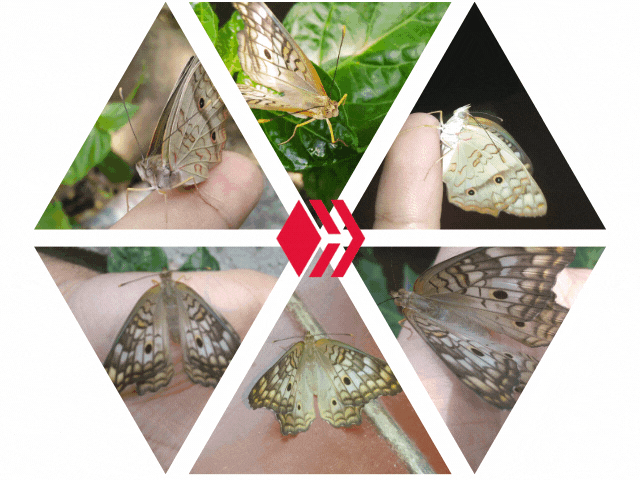
El presente artículo se realizó con la finalidad de dar a conocer aspectos de interés sobre la mariposa Anartia jatrophae la cual pertenece a la familia Nymphalidae. Este lepidóptero como los demás, tienen un papel muy importante en los hábitats terrestres, sitios en donde forman parte de la cadena alimenticia y contribuyen en la polinización de especies vegetales, por lo que el cuidado y respeto de los artrópodos es necesario para garantizar la permanencia de otros organismos y para mantener un correcto funcionamiento de los ecosistemas.
This article was written with the purpose of informing about aspects of interest about the butterfly Anartia jatrophae which belongs to the family Nymphalidae. This lepidopteran, like the others, has a very important role in terrestrial habitats, sites where they are part of the food chain and contribute to the pollination of plant species, so the care and respect for arthropods is necessary to ensure the permanence of other organisms and to maintain proper functioning of ecosystems.

Todas las fotografías presentadas en esta publicación pertenecen al autor @abneagro, las fotos fueron realizadas con un dispositivo movil Redmi 8A y editadas con la aplicación Canva.
All the photographs presented in this publication belong to the author @abneagro, the photos were taken with a Redmi 8A mobile device and edited with the Canva application.

Some references:
Study by Professor Sunghwan "Sunny" Jung

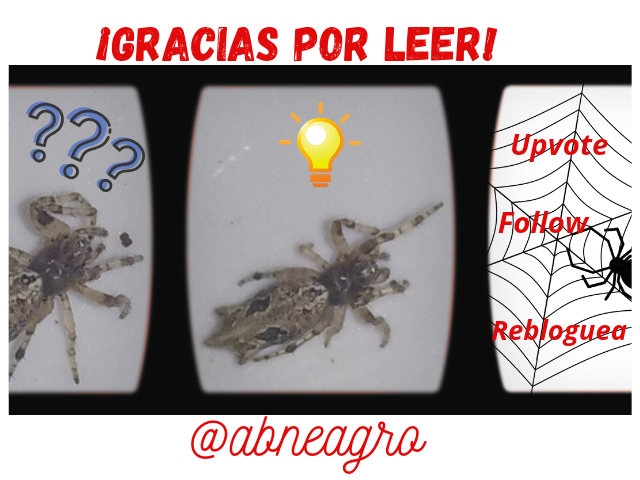
Buenas tardes. Excelente publicación. Conocer y comprender a los miembros del filo Arthropoda nos garantiza el futuro provechoso de la agricultura. Saludos. aliriera
Muchas gracias por su visita y por el comentario positivo amigo Ali, saludos!
Hola estimado amigo @abneagro, siempre en un placer poder leer tus excelentes artículos relacionadas al mundo de los insectos, este tipo de mariposas son muy hermosas ya que las he podido observar en muchas ocasiones en algunos lugares de mi casa, gracias amigos por compartir tan magistral contenido con todos nosotros. Saludos y muchos bendiciones para ti y tu familia.
Muchas gracias por su comentario amigo Balzan, ciertamente estas mariposas son de las más comunes en nuestro país, saludos!
Congratulations @abneagro! You have completed the following achievement on the Hive blockchain and have been rewarded with new badge(s) :
Your next payout target is 5000 HP.
The unit is Hive Power equivalent because your rewards can be split into HP and HBD
You can view your badges on your board and compare yourself to others in the Ranking
If you no longer want to receive notifications, reply to this comment with the word
STOPTo support your work, I also upvoted your post!
Check out the last post from @hivebuzz:
Muchas gracias por el recordatorio, nos seguimos leyendo!
De nada @abneagro
Apóyenos también y vote por nuestro testigo.
Recibirá una insignia adicional y un voto más fuerte de nuestra parte cuando le notifiquemos.
Congratulations, your post has been upvoted by @dsc-r2cornell, which is the curating account for @R2cornell's Discord Community.
Thanks for the support!
Thanks for your contribution to the STEMsocial community. Feel free to join us on discord to get to know the rest of us!
Please consider supporting our funding proposal, approving our witness (@stem.witness) or delegating to the @stemsocial account (for some ROI).
Please consider using the STEMsocial app app and including @stemsocial as a beneficiary to get a stronger support.
Thanks for the support :)
We appreciate your work and your post has been manually curated on behalf of Insects Of The World Community. It will be added to the weekly curation report. Keep up the good work
Thanks for the support!
Excelente post!. Aquí he visto ese bello ejemplar y he publicado sobre el. No conocía tantos detalles como, por ejemplo, su aspecto en fase larvaria. Gracias por compartir @abneagro, he aprendido bastante y espero seguir haciéndolo con la ayuda de Dios y de sus publicaciones.
Muchas gracias por la valoración positiva hacia mi publicación @elentogether, bienvenida a mi blog. En efecto, he visto muchas publicaciones en HIVE sobre esta linda y común mariposa, es por ello que decidí tocar más a fondo los aspectos relevantes sobre este ejemplar a modo de complementar toda la información que ya se ha compartido en esta plataforma. Me alegra que mi publicación haya sido de su agrado y lo mejor, es que pudo aprender cosas interesantes sobre esta mariposa, es siempre bienvenida a mi blog, saludos!